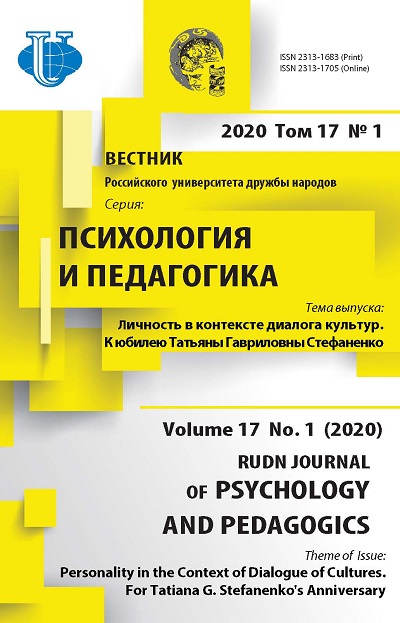Tatiana G. Stefanenko’s Impact to the Development of Ethnopsychological Research in Azerbaijan
- Authors: Shirkov Y.E.1, Azimzade A.A.2, Hasanova U.U.3, Novruzova L.Z.4
-
Affiliations:
- Lomonosov Moscow State University
- İnstitute of Education of the Republic of Azerbaijan
- Baku State University
- Baku International Education Complex
- Issue: Vol 17, No 1 (2020): PERSONALIТY IN ТНE CONТEХТ OF DIALOGUE OF CULТURES. FOR TAТIANA G. SТEFANENKO’S ANNIVERSARY
- Pages: 196-208
- Section: SCIENCE CHRONICLE
- URL: https://journals.rudn.ru/psychology-pedagogics/article/view/23306
- DOI: https://doi.org/10.22363/2313-1683-2020-17-1-196-208
Cite item
Full Text
Abstract
The article provides a brief historical survey of the Azerbaijani school of ethnopsychological research, revealing the role of T.G. Stefanenko in its development. The authors present the results accumulated during the first years of ethnopsychological studies in Baku under the direct supervision of T.G. Stefanenko: (1) features of the ethnic identity of adolescents from Azerbaijani and Azerbaijani-Russian families; (2) cross-cultural differences in the value orientations of students living in Azerbaijan and Russia; and (3) the relationship of the time perspective and characteristics of ethnic identity among representatives of Azerbaijani and Russian cultures.
About the authors
Yuri E. Shirkov
Lomonosov Moscow State University
Author for correspondence.
Email: shirkov@mail.ru
Ph.D. in Psychology, is senior researcher at the Department of Social Psychology, Faculty of Psychology
11 Mokhovaya St., bldg. 9, Moscow, 125009, Russian FederationAydan A. Azimzade
İnstitute of Education of the Republic of Azerbaijan
Email: aydaska_1495@mail.ru
MA in Psychology, is a specialist of the Psychological Service Department
96 Zarifa Aliyeva St., Baku, AZ1010, Republic of AzerbaijanUlkar U. Hasanova
Baku State University
Email: ulkar.h.u@gmail.com
MA in Psychology, is a lecturer at the Department of Social and Pedagogical Psychology, Faculty of Psychology and Social Sciences
23 Academic Zahid Khalilov St., Baku, AZ1148, Republic of AzerbaijanLeyla Z. Novruzova
Baku International Education Complex
Email: leylashirinova@yahoo.com
MA in Psychology, is a psychologist in Baku International Education Complex
54 Matbuat Ave., Baku, AZ 1148, Republic of AzerbaijanReferences
- Aspinwall, L.G. (2005.) The psychology of future-oriented thinking: From achievement to pro-active coping, adaptation, and aging. Motivation and Emotion, 29, 203–235.
- Azimzade, A.A. (2016). Kross-kul'turnyy analiz tsennostnykh oriyentatsiy azerbaydzhanskikh i russkikh studentov. Lomonosov-2016: Conference Proceedings. Moscow: Lomonosov Moscow State University Publ. (In Russ.)
- Dontsov, A.I., Stefanenko, T.G., & Utaliyeva, Zh.T. (1997). Yazyk kak faktor etnicheskoy identichnosti. Voprosy Psikhologii, (4), 75–86. (In Russ.)
- Gary, K., & James, W. (1991). The Development of Time Orientation Measures For Use in Cross-Cultural Research. Advances in Consumer Research, 18, 135–142.
- Gozma, I. (2011). How are individualism and collectivism measured? Romanian Journal of Applied Psychology, (1), 11–17.
- Hasanova, U.U. (2016). Vremennaya perspektiva i faktory, vliyayushchiye na yeye sbalansirovannost'. Lomonosov-2016: Conference Proceedings. Moscow: Lomonosov Moscow State University Publ. (In Russ.)
- Matsumoto, D. (2003). Psikhologiya i Kul'tura. Saint Petersburg: Praym-Yevroznak Publ. (In Russ.)
- Schwartz, S.H. (2012). An Overview of the Schwartz Theory of Basic Values. Online Rea- dings in Psychology and Culture, 2(1). https://doi.org/10.9707/2307-0919.1116
- Shirinova, L.Z. (2017). Osobennosti etnicheskoy identichnosti studentov iz azerbaydzhanskikh i russko-azerbaydzhanskikh brakov. Lomonosov-2017: Conference Proceedings. Moscow: Lomonosov Moscow State University Publ. (In Russ.)
- Sircova, A., Sokolova, E.T., & Mitina O.V. (2008). Adaptation of Zimbardo Time Perspective Inventory. Psikhologicheskiy Zhurnal, (3), 101–109. (In Russ.)
- Stefanenko, T.G. (2014). Etnopsikhologiya. Moscow: Aspekt Press Publ. (In Russ.)
- Stefanenko, T.G. (2012). Etnopsikhologiya: Praktikum. Moscow: Aspekt Press Publ. (In Russ.) Tizard, B., & Phoenix, A. (1989). Black identity and transracial adoption. New Community, 15(3), 427–438.
- Triandis, H.C. (1996). The psychological measurement of cultural syndromes. American Psychologist, (4), 407–415.
- Zimbardo, P.G., & Boyd, J.N. (1999). Putting time in perspective: A valid, reliable individualdifference metric. Journal of Personality and Social Psychology, 77, 1271–1288.















